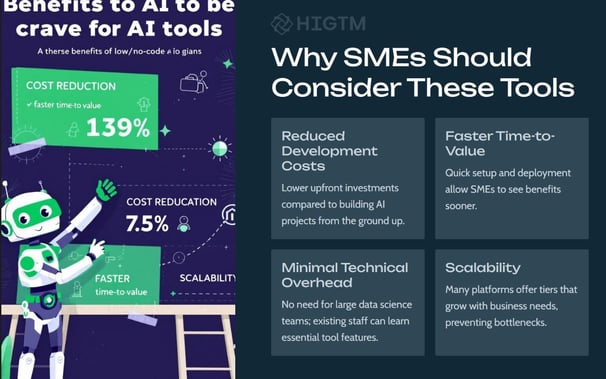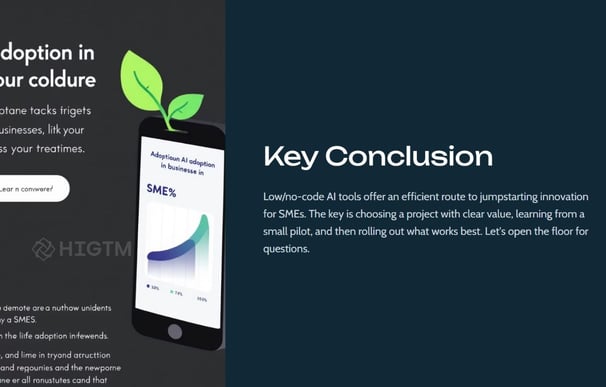14. Early-Stage AI Tools: Low/No-Code Solutions for SMEs
By focusing on simple, highly impactful AI applications, SMEs can quickly demonstrate tangible benefits—reducing operational costs, boosting sales conversions, or streamlining internal processes. In this post, we’ll explain what low/no-code AI tools are, why they’re suited for SMEs, and how to implement them effectively. We’ll also highlight practical use cases—like automated lead qualification and chatbots—that can deliver rapid wins. Whether you’re brand-new to AI or exploring ways to expand existing capabilities, these accessible platforms provide a fast route to data-driven innovation.
Q1: FOUNDATIONS OF AI IN SME MANAGEMENT - CHAPTER 1 (DAYS 1–31): CORE AI CONCEPTS & VALUE PROPOSITION
Gary Stoyanov PhD
1/14/20256 min read

1. Understanding Low/No-Code AI Tools
Low-code or no-code AI platforms offer user-friendly interfaces—drag-and-drop components, pre-built workflows, and automated model training—that drastically reduce the need for in-depth programming expertise. Instead of manually coding algorithms from scratch, you configure modules and data pipelines through visual dashboards or guided wizards.
Key Features
Pre-Built Templates
Ready-made solutions for tasks like lead scoring, chatbot creation, or document processing.
Automated Model Training
The platform handles the underlying machine learning, letting you choose data sources and target variables with minimal coding.
Simplified Data Integration
Connects to your CRM, ERP, or other databases easily—often through cloud-based connectors.
Drag-and-Drop Interfaces
Visual workflows, so non-technical employees can define logic or map how data flows from one step to another.
Result: SMEs can rapidly prototype and deploy AI-driven applications without hiring specialized data scientists.
This is a transformative approach, especially for businesses looking to test AI’s potential or address a specific pain point (like automating support queries) with limited resources.
2. Why SMEs Should Consider Low/No-Code AI
By eliminating heavy upfront coding requirements, low/no-code platforms free SMEs to focus on tangible business outcomes—like better lead targeting or simpler invoice handling—rather than worrying about complex technical stacks.
2.1 Reduced Development Costs
Instead of building custom AI solutions from the ground up, SMEs can:
Use subscription-based platforms that require minimal capital investment.
Avoid the overhead of large data science teams or in-house AI experts.
Tap into pre-configured modules for faster time-to-market.
Benefit: Faster ROI, as you direct resources toward pilot projects with immediate impact (like automating data entry) rather than paying big money for advanced code-based systems you may not fully utilize.
2.2 Faster Time-to-Value
Low/no-code AI typically has a straightforward setup—weeks or even days rather than months or years. This aligns with SME needs:
Quickly Prove Feasibility: Develop a proof-of-concept chatbot or recommendation engine in a fraction of the time.
Iterate Rapidly: Tweak or reconfigure your workflow as you gather feedback, refining the solution to ensure it addresses the real challenge effectively.
Result: Shorter pilot phases, letting your team see instant wins that validate AI’s worth before considering broader expansions.
2.3 Minimal Technical Overhead
With the platform handling model training and hosting, your existing staff can learn fundamental configuration and maintenance. This spares you from:
Managing specialized AI infrastructure in-house
Wrangling large datasets manually
Navigating deeply technical coding or algorithm tuning
Payoff: Non-technical employees can own or champion AI solutions. By democratizing AI usage, you embed data-driven thinking across departments, from customer support to finance.
2.4 Scalability
Most low/no-code AI tools use cloud-based hosting, meaning you can scale usage up or down based on your SME’s demand without major overhauls. As business grows—or if you add new product lines—you simply upgrade your service tier or connect additional data sources.
3. Key Examples & Use Cases
Low/no-code AI platforms address a wide array of tasks. Below are four typical applications that SMEs can quickly implement to solve pressing operational or customer-related challenges.
3.1 Automated Lead Qualification
Use Case: Label and score inbound leads so sales teams focus on the most promising opportunities first.
Why It’s Valuable: Reduces time spent on cold leads, raising conversion rates and overall sales efficiency.
How It Works: Users feed lead data (web form entries, CRM records) into a simple classification model or scoring engine. The tool automatically updates lead scores or flags high-potential prospects for immediate follow-up.
Quick Tip: Track improvements in sales velocity or close rates to quantify ROI, showing how the low-code AI drastically boosts funnel efficiency.
3.2 Chatbots & Customer Support
Use Case: Deploy chatbots or AI-driven help desks that address FAQs, appointment bookings, or product/service issues.
Why It’s Valuable: 24/7 availability for quick resolutions, fewer repetitive tickets for human agents, improved customer satisfaction.
How It Works: You select a no-code chatbot builder. Pre-pack chat flows with responses to common queries. Over time, integrate NLP for more nuanced question handling.
Quick Tip: Start with a small FAQ or a single product line, gather usage data, and then refine or expand to other areas once proven effective.
3.3 Document Processing
Use Case: Extract data from invoices, contracts, or receipts using OCR (Optical Character Recognition) and AI-based classification.
Why It’s Valuable: Eliminates manual data entry, cuts down human errors, and speeds up administrative workflows.
How It Works: The platform scans documents, detects relevant fields (amount, due date, vendor), and auto-populates forms or updates your accounting system.
Quick Tip: If you handle high volumes of similar documents (like sales invoices), this approach can free staff hours daily—immediate cost savings.
3.4 Demand Forecasting
Use Case: Predict future sales or stock requirements without advanced machine learning coding.
Why It’s Valuable: Minimizes overstock or stockouts, smoothing cash flow and preventing lost sales.
How It Works: Provide historical sales data, seasonal trends, and relevant factors (promotions, local events). The tool uses time series or regression models to forecast demand, updating reorder points automatically.
Quick Tip: Validate forecast accuracy over a few cycles. If your predictions keep overshooting, refine the data or incorporate new variables (like weather or competitor activity).
4. Practical Implementation Steps
While these platforms are designed for simplicity, upfront planning ensures your quick pilot or project yields the best results. Below is a concise guide to integrating low/no-code AI tools into your SME’s operations.
4.1 Identify the Pain Point
Focus: Zero in on a clear operational challenge—like frequent stockouts, manual invoice tasks, or overwhelmed support lines.
Benefit: When you fix a known bottleneck, measuring ROI becomes straightforward. If your call center is swamped, implementing an NLP chatbot can quickly demonstrate reduced wait times.
4.2 Evaluate Available Platforms
Focus: Compare features, pricing, and support among various low/no-code vendors—some excel in chatbots, others in analytics or image recognition.
Benefit: You avoid investing in a tool that’s either too advanced (costly, complicated) or too basic (missing the features you need).
Consider:
User-Friendliness: Are the drag-and-drop components intuitive for your staff?
Integration Options: Does the tool easily connect with your CRM, e-commerce, or finance systems?
Security & Data Compliance: For regulated industries, ensure the platform follows standards like GDPR or HIPAA.
4.3 Map Out Processes
Focus: Document the workflow you aim to automate or enhance with AI. For chatbots, define conversation flows. For demand forecasting, identify data inputs (sales logs, seasonality) and outputs (purchase orders).
Benefit: This clarity speeds up tool configuration and ensures you cover critical edge cases (like escalations for support or outlier days in your data).
4.4 Pilot & Iterate
Focus: Start with a limited data set or a specific user group to test the solution’s accuracy and user experience.
Benefit: If the pilot underperforms, you can refine it with minimal risk. Gather feedback from staff or customers to address usability gaps.
Example: Launch your new chatbot on a single product page or direct support line. If results are positive (better response times, fewer tickets), expand to the rest of your site.
4.5 Measure ROI & Communicate Success
Focus: Track key metrics—like time saved, cost reduction, error rate improvements, or new revenue.
Benefit: Demonstrating a quick ROI fosters organizational confidence in scaling the solution or exploring other AI use cases. Communicate these wins in staff meetings or departmental newsletters to spread enthusiasm.
Tip: For intangible outcomes like improved morale, use proxies such as employee satisfaction surveys or reduced turnover. Even if results are partly anecdotal, they paint a fuller picture of the tool’s benefits.
5. Key Conclusions
Low/no-code AI tools have opened a gateway for SMEs to tap into AI benefits—like streamlined customer support, accelerated sales processes, or agile demand forecasting—without requiring deep technical teams or hefty budgets.
By focusing on manageable use cases, establishing the right metrics, and iterating on pilot successes, smaller businesses can realize immediate value and build organizational momentum for further AI adoption.
Key Takeaways:
Accessibility: Low/no-code AI platforms remove traditional barriers, allowing staff with minimal coding skills to build and deploy AI applications.
Versatility: From automated lead scoring and chatbots to document processing and demand forecasting, these tools address diverse SME needs.
Strategy & Measurement: Define the problem precisely, select a suitable tool, run a pilot, and track key metrics to confirm ROI.
Scalability: Begin with a small project that showcases quick wins; once proven, replicate or scale that model across departments or other use cases.
If you’re an SME leader aiming to harness AI quickly and efficiently, HIGTM can guide you to the low/no-code solutions that best fit your scenario—helping define your objectives, evaluate platforms, and integrate them seamlessly.
Embracing these accessible AI tools is often the fastest route to data-driven innovation, providing a solid foundation for deeper AI growth as your organization evolves.




Turn AI into ROI — Win Faster with HIGTM.
Consult with us to discuss how to manage and grow your business operations with AI.
© 2025 HIGTM. All rights reserved.
